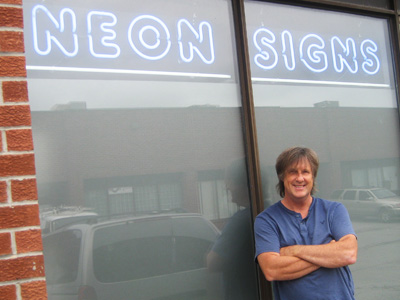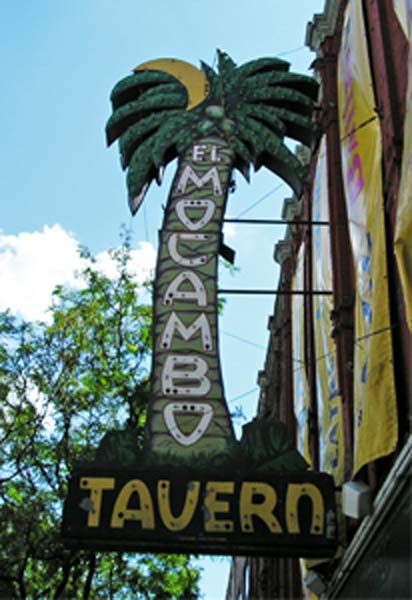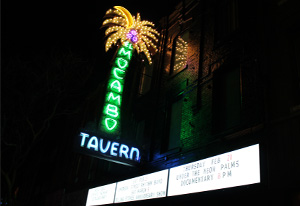 By Peter Saunders
By Peter Saunders
On September 17, El Mocambo co-owner Sam Grosso confirmed the nearly 70-year-old concert venue on Spadina Avenue in downtown Toronto would be closing on November 6. The ‘for sale’ sign had been up for months and a conditional deal was finally being worked out with an unspecified buyer. It could mean the end of an era for a venue known not only for its run of shows by Bob Marley, April Wine, The Rolling Stones (performing as The Cockroaches in 1977), Jimi Hendrix, The Ramones, Billy Idol, Elvis Costello, Blondie and U2, but especially for its iconic neon palm tree sign, unless it is preserved and/or incorporated into the reworked building.
The last shop to work on that sign was Hope Neon, back in 2012 when Grosso and Marco Petrucci bought the venue from Abbas Jahangiri and the neon needed refurbishing. It was restored at a reported cost of $20,000.
Grant Farrell, the current owner of Hope Neon, has successfully found a niche for his trade in Toronto handling these sorts of projects—not just restorations, but also making entirely new, customized, exposed ‘skeletal’ neon signs for local restaurants, bars and nightclubs, including Grosso’s popular rockabilly venue, the Cadillac Lounge, on the increasingly illuminated stretch of Toronto’s Queen Street West that includes the neighbourhood of Parkdale. Frequently dubbed ‘West Queen West,’ the area was recently named the second hippest district in the world by Vogue magazine, behind only Shimokitazawa in Tokyo, Japan.
“With the rise of West Queen West, most of my recent work has been for venues along that stretch,” says Farrell.
Indeed, one might say neon is hip all over again.
 Building a competitive advantage
Building a competitive advantage
Glass bender Rudy Hope founded his eponymous shop on Toronto’s Maitland Avenue in 1958, when exposed neon was a mainstream medium for signage. He had previously made glass tubes for the federal government that were used in radar systems during the Second World War.
There were still many neon tube benders like Hope working throughout Toronto when Farrell joined the industry in 1983 by delivering supplies to sign shops.
“I had a musical background and the artistic side of neon signs had a similar feeling of fun that attracted me,” Farrell says. “There was still high demand back then, but many of the neon shops in Toronto were old and not very customer-service-oriented, so I saw a business opportunity. I asked them to hire me and they kept saying no, no, no. I was even willing to work for free!”
By this point, Hope Neon was operating out of Steel Art Signs’ facilities in the east end of the city, where Farrell would often deliver supplies.
“Rudy was renting a space there and started thinking about selling his business,”
says Farrell. “I offered to work for free for one year to learn the trade and then take it over. He said okay. I was only about 20 years old and had to ask my parents to get a lawyer to write up the deal.”
Farrell started working at Hope Neon in 1984 and crammed as much learning as he could into that first year. He also worked at another shop, Quality Neon, on weekends and explains he practised glass blowing every night in his parents’ garage. When he took over Hope Neon in January 1985, he had one older part-time employee and one part-time trainee working with him.
 “I started knocking on the doors of sign companies and offered to deliver finished neon tubes to them, with a two-day turnaround,” he says. “They had never seen that level of service before. They used to have to pick up the tubes themselves from the neon shops!”
“I started knocking on the doors of sign companies and offered to deliver finished neon tubes to them, with a two-day turnaround,” he says. “They had never seen that level of service before. They used to have to pick up the tubes themselves from the neon shops!”
With this competitive advantage, Hope Neon’s customer base grew quickly. In 1986, the shop moved with Steel Art Signs to nearby Markham, Ont. Farrell moved the business again to the site of its biggest customer, Smith Signs, also in Markham, before eventually finding his own dedicated 204-m2 (2,200-sf) industrial space in adjacent Scarborough, Ont., in 1999.
“With our growth, we gained two to three people each year,” he says. “We ended up with 17 full-time employees working both day and night shifts and two vans on the road all of the time for deliveries. We were making neon tubing for illuminated signs—mostly channel letters—for every Tim Hortons, Ford dealership, Canadian Tire and Burger King across Canada. That was because we had enough guys. As we got more staff, we became the only ones who could handle these big projects.”
The timing of Hope Neon’s expansion under Farrell also fortunately coincided with a period of major growth for retailers and other commercial enterprises. The West Edmonton Mall, for example, had opened in 1981 and been expanded in 1983, 1985 and 1999, housing more stores and their signs as it became the largest mall in North America.
“A lot of big national chains used the big sign companies here in Toronto, like Pattison Sign Group, which were our customers,” Farrell explains. “Even when we used all of the space in our shop, it was very crammed and crowded here.”





